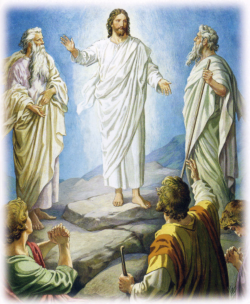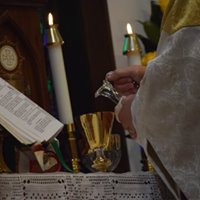Transfiguration: OT and NT Testament
What is the Significance of the Transfiguration of Jesus Christ?
(Mark 9:2-9) The account of the transfiguration of Jesus Christ as recorded here in Mark (parallel passages are found in Matthew 17:1-3 and Luke 9:28-36) is a demonstration to three witnesses that Jesus Christ was who He claimed to be. In all three accounts of the transfiguration of Jesus Christ, we are given the names of the three disciples who accompanied Jesus and who stood as human witnesses to the glory that was Christ’s. There were also three heavenly witnesses — Moses, Elijah, and the voice of God from heaven. Therefore, the Old Testament law of three witnesses required to attest to any fact (Deuteronomy 19:15) was satisfied both in earth and in heaven.
We have, in the account given in the Gospels of Matthew, Mark and Luke, a glorious and faith confirming event that had a profound effect on the three Apostles who were privileged to witness it. These three were given a view to which none other than the host of heaven was privy – the glorious transfiguration of Christ into His Heavenly state of Holiness, Light, and Eternal Being in the Kingdom of God. The words of Jesus in (Mark 1) are particularly noteworthy to this event. – But I tell you of a truth, there be some standing here, which shall not taste of death, till they see the kingdom of God. Christ is providing them with the news that they will soon glimpse His Heavenly Glory and coming Kingdom of God. This was a preview of what they would see and know following the resurrection when all was finished!
When we wish to come near to God, we should go where we are assured of solitude. Mountains take us to a higher plane, and also provide assured privacy. As we come nearer to the peak of the mountain, there is only a small patch of terrain for our position. Additionally, when we are on the mountain, we are nearer to God because the world is far from us as we look down on the small features of the familiar world.
The word “transfigured” is a very interesting word. The Greek word is “metamorpho” and it means to transform, literally or figuratively to metamorphose, or to change. The word is a verb that means to change into another form. It also means to change the outside to match the inside. The prefix “meta” means to change and the “morphe” means form. In the case of the transfiguration of Jesus Christ it means to match the outside with the reality of the inside. To change the outward so that it matches the inward reality. Jesus’ divine nature was “veiled” (Hebrews 10:20) in human form and the transfiguration was a glimpse of that glory. Therefore, the transfiguration of Jesus Christ displayed the Shekinah glory of God incarnate in the Son. The voice of God attesting to the truth of Jesus’ Sonship was the second time God’s voice was heard. The first time was at Jesus’ baptism into His public ministry by John the Baptist. (Matthew 3:7; Mark 1:11; Luke 3:22) As Christ prayed, the Kingdom of God began to materialize before the eyes of the onlookers. Not only did the bodily features of Christ begin to change, but even His raiment became immaculately white and even resplendent in their bright beauty. Moses and Elias (Hellenic for Elijah), who appeared in glory but still as men, appeared by the side of Christ and discussed His coming death. One of these men had known physical death for God had shown him all the Promised Land from the heights of Mount Pisgah, and he died there. God Himself buried Moses. The other, Elijah, had not known physical death for he was translated in a Chariot of Fire. When the Kingdom comes in the fullness of time, some will still be living who know the Lord. They will likewise never see physical death, but others, like Moses (no less cherished by God) sleeps in the dust until that great moment comes.
The Apostles were amazed at the sight of the glorified Christ in the presence of Moses and Elijah. It is quite remarkable that, even though they were not told the identity of the two Prophets present, they nonetheless recognized them. When we are in Christ in the coming glory, many mysteries will likewise be known to us without the asking.
Poor Peter, being a speaker always before a thinker, remarked that they should build three tabernacles on the spot: one for Christ, and one each for the two prophets. In so doing, Peter was unwittingly placing the prophets on the same par with Christ. We should never consider any man, regardless his piety or devotion, on a level with God. We believe all things, not because some inspired man has spoken them, but because God has spoken in His Word.
“While he thus spake, there came a cloud, and overshadowed them: and they feared as they entered into the cloud. And there came a voice out of the cloud, saying, “This is my beloved Son: hear him.“” I do believe the message could be any clearer or simple: “Let God be true and every man a liar” (Romans 3:4) Regardless what gifted minister may say, it is our duty to confirm all things heard or spoken with Holy Scripture. If God has not spoken it, a million words of a great man will not alter the truth one iota.
After the voice had spoken, the cloud lifted. That should always be true in the Christian’s understanding – once God has addressed a matter, it is finally settled for good – no questions, not rationalization, no equivocation! And as the cloud lifted, in order to emphasize the point, Christ was found alone. It is to Christ alone that we owe our redemption and to Him alone that we must seek succor. “This is my Beloved Son: hear Him!” This was God’s command to the Apostles, and it is God’s command to us on this Day of Transfiguration, and every day! AMEN
The Son of God came to earth in the form of a man to be the true servant of God and to gift mankind with the greatest gift ever given, eternal life. The transfiguration of Jesus Christ was a visible sign in the presence of reliable witnesses of the reality of the power of God and the glory, which is Christ Jesus. (2nd Peter 1:13-19)
Bishop Jerry L. Ogles




